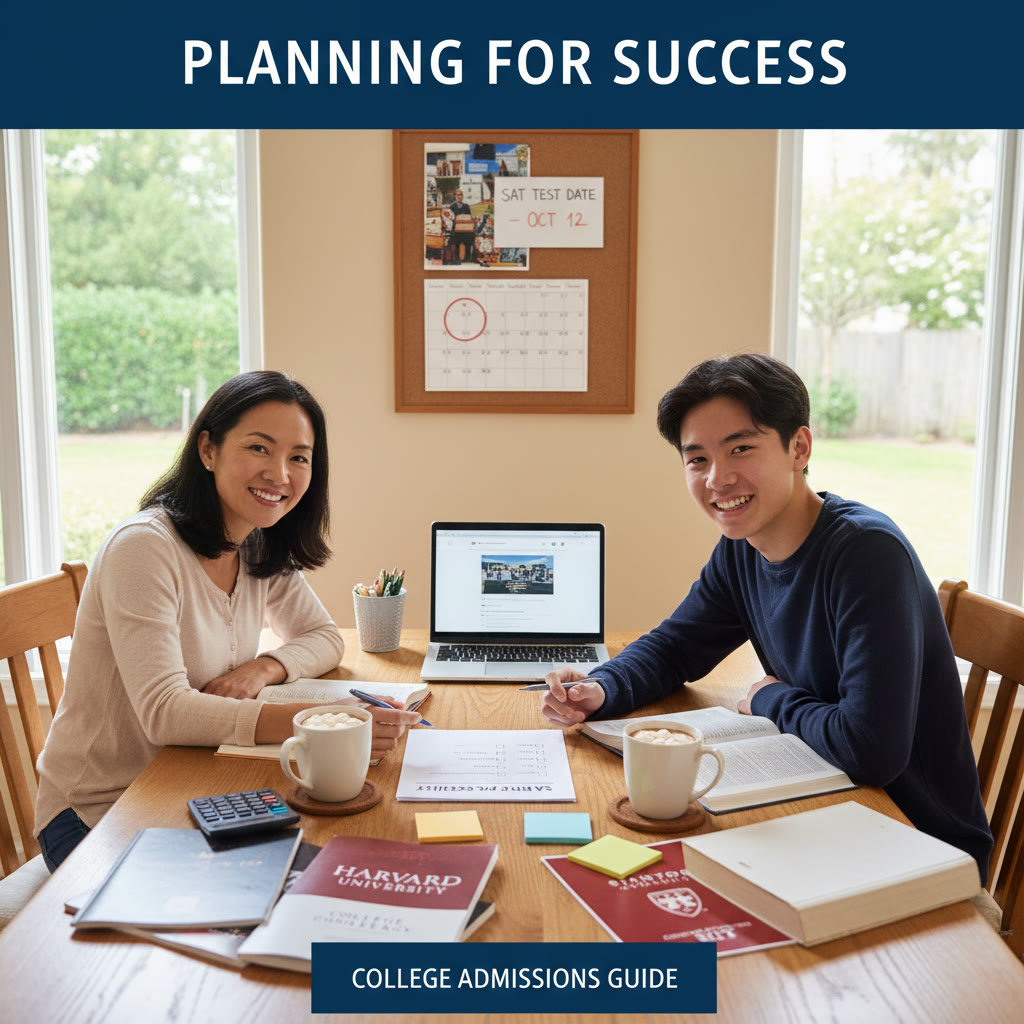Why this matters: The SAT and your University of Oregon application
Planning for college can feel like juggling while walking a tightrope: grades, essays, extracurriculars, recommendations — and the SAT. If the University of Oregon (UO) is on your list, you’re asking the right questions: Do I need to submit SAT scores? What score should I aim for? How do admissions officers use these scores alongside the rest of your application?
This guide breaks it down in plain language, gives you practical steps, and shows how to prioritize your time so you and your family can make confident decisions — without the overwhelm.

Short answer: What UO expects from SAT test-takers
The University of Oregon considers SAT scores when they are submitted, but recent admissions practice has been more flexible across many public universities. UO reports a typical middle 50% SAT range for incoming students — a useful benchmark to see where your scores fit among admitted applicants.
Understanding that middle 50% range is important: it’s the range between the 25th and 75th percentiles for admitted students. If your score sits within that range, UO likely sees you as a match for their general applicant pool. Below it, your application might be a reach unless other parts of your application are especially strong; above it, you’ll be in a more competitive space.
Typical SAT score range to target
For admitted students at the University of Oregon, the commonly reported SAT score range (the middle 50%) is roughly in the low 1100s to mid 1300s. Use this as a target zone:
- Stretch goal (aim high): 1360 or above — increases your competitiveness for selective scholarships and honors programs.
- Realistic match goal: About 1230–1290 — places you near the middle of admitted applicants.
- Safety/solid baseline: 1130 — still within the range and acceptable when balanced with a good GPA and activities.
Keep in mind these numbers are benchmarks, not strict cutoffs. Admissions teams evaluate applications holistically: coursework, trend lines in your grades, essays, leadership, and recommendations all matter.
Test-optional? What that means for your application strategy
Many colleges, including public universities, have shifted policies since the pandemic. Test-optional means you can choose whether to submit SAT scores. If you have a strong score that reflects your academic strengths, submit it. If your score is significantly below your GPA-derived academic profile, consider focusing on other parts of your application instead.
When to submit SAT scores
- Submit your scores if they are at or above the middle 50% for UO — it strengthens the application.
- If your academic record is strong and your SAT is slightly below the range, submit only if it complements other evidence (e.g., upward grade trend, AP scores, or subject mastery).
- Omit scores when they distract from a stronger academic narrative, unless scholarships or specific departmental programs explicitly require them.
How admissions actually use SAT scores
Admissions officers use SAT scores as one quantitative piece of your file. They can help corroborate your transcript — especially if you come from a high school with less-known grading standards — and can be useful for award decisions. But a single test won’t define you.
Important nuance: Some programs or scholarships at UO may still give weight to test scores even if the university is broadly test-optional. Always check program-specific requirements if you’re applying to majors with additional selection criteria (for example, some honors or competitive STEM tracks).
Practical timeline: When to take the Digital SAT and how many times
The Digital SAT offers more flexible sign-ups and section-adaptive design, which changes how you practice. Here’s a practical timeline based on a typical junior-senior cycle.
Suggested testing schedule
| When | What to do | Why |
|---|---|---|
| Spring of junior year | Take a full-length official practice Digital SAT (timed) | Baseline score and identify weaknesses ahead of senior year |
| Summer after junior year | Targeted study (content + timing), practice adaptive sections | Build skills without the school-year stress |
| Early fall senior year | First official Digital SAT administration | Receive scores in time for early action decisions |
| Late fall / winter senior year | Retake once or twice as needed | Focus on small, high-impact improvements |
Two well-prepared attempts are common: an early senior-year test for early decision/early action, and a second to improve. Most students see their biggest gains in focused practice between attempts.
Study plan essentials: What actually moves your score
Improvement is rarely about cramming; it’s about targeted practice and strategy. Here’s a compact study architecture that works for most students.
Core elements of an effective plan
- Diagnostic first: Take a timed official Digital SAT to find your baseline.
- Skill blocks: Break practice into reading, writing & language, and math (calculator & no-calculator style problems), plus timing practice for multi-stage adaptive sections.
- Weekly micro-goals: Two or three focused drills per week on specific weaknesses (e.g., data interpretation or paragraph analysis).
- Full practice tests: One per week in the final month before test day to build stamina and timing instincts.
- Review routine: For every missed question, write a short note: Why did I miss it? What’s the rule or strategy to avoid it next time?
Tools and techniques that help
- Official practice materials: No substitute for real Digital SAT practice prompts and interface.
- Active reading: Annotate passages, summarize paragraphs in a phrase, and predict question types.
- Equation toolbox for math: Memorize common identities and reframe complex problems into simpler arithmetic or algebra steps.
- Simulation practice: Do at least two tests in the exact conditions of test day — same timing, no distractions.
Balancing SAT prep with the rest of your application
Admissions is holistic. Your SAT is one important piece, but it doesn’t have to dominate your senior year. Here’s a checklist to help you allocate time wisely:
- Keep coursework strong — a consistent GPA and A– to A grades in core subjects matter more than a single test score.
- Draft your essays early. Great essays can elevate an application even when test scores are average.
- Show sustained activities and leadership: clubs, sports, work, or community projects with a clear role and growth.
- Plan teacher recommendations thoughtfully — choose teachers who can speak to your academic strengths and character.
How to interpret the numbers: A simple decision framework
Here’s a quick decision flow to decide whether to submit scores to UO:
- If your SAT is at or above UO’s 75th percentile → submit (helps).
- If your SAT falls within the middle 50% → you’re a match; submit if it strengthens your narrative.
- If your SAT is below the 25th percentile → skip submission unless you have a compelling reason (e.g., strong upward grade trend, AP/IB scores, or subject-specific achievements).
Example scenarios
- Student A: 3.9 GPA, SAT 1350 — should submit; score supports strong academic profile.
- Student B: 3.5 GPA, SAT 1120 — optional; consider submitting if other parts of the application are exceptional or if required for scholarships.
- Student C: 4.0 GPA, SAT 1180 but significant leadership and research — could omit scores, letting accomplishments drive the file.
Scholarships, honors, and program-specific testing rules
Even if UO is broadly test-optional, certain scholarships, departmental honors programs, or competitive majors may have their own testing expectations. If you’re aiming for a funded scholarship or a selective program, check that program’s requirements early and aim for the highest reasonable score.
Putting numbers into a scholarship context
Higher SAT scores can unlock merit-based awards. If you’re aiming for financial aid based on merit, a deliberate retake to improve by 20–40 points can be worth the investment, especially when combined with a polished application.
How parents can help without micromanaging
Supporting a student through SAT prep is a balancing act. These are ways parents add value without adding stress.
- Create structure: Quiet study times, a consistent schedule, and small rewards for milestones.
- Provide resources: Official practice tests, a quiet workspace, and access to tutoring if needed.
- Encourage balanced perspective: Celebrate improvements and emphasize the application as a whole.
- Help logistics: Registering for the Digital SAT, arranging transportation, and ensuring testing day readiness.
When personalized help makes sense — and how it pays off
Some students plateau with self-study. That’s where targeted, 1-on-1 guidance can move the needle quickly. Personalized tutoring identifies specific weaknesses, builds a tailored study plan, and provides accountability — a combination that often shortens the road to a better score.
Sparkl’s personalized tutoring is one example of how tailored support can help: one-on-one sessions focus on high-impact strategies, create a customized timeline, and bring expert tutors who understand how to coach a student through the adaptive Digital SAT format and application priorities. That kind of support is especially helpful for students balancing coursework, activities, and early applications.
Practice data: Example weekly plan (8-week sprint)
Here’s a sample 8-week study sprint a student could follow leading to a test date. Adjust intensity to match baseline and goals.
| Week | Focus | Tasks |
|---|---|---|
| 1 | Diagnostic & baseline | Full practice Digital SAT; error log; create study calendar |
| 2 | Reading strategies | Passage annotation drills; timed sets; vocabulary-in-context practice |
| 3 | Writing & language | Grammar rule review; practice sets; timing |
| 4 | Math fundamentals | Algebra review, data analysis, calculator strategies |
| 5 | Application of skills | Mixed practice sections; targeted review on biggest error types |
| 6 | Full practice test & review | Simulated test; comprehensive review and strategy tweak |
| 7 | Polish weak areas | Micro-drills; pacing practice; question-type mastery |
| 8 | Final prep & rest | Light review, sleep plan, test-day logistics |
Test day: logistics and mental game
Test day is a combination of logistics and mindset. Small details add up.
- Bring your admission ticket and approved ID.
- Practice the exact wake-up and breakfast routine on a practice-test day.
- Use breathing techniques before the test and between sections to keep nerves in check.
- Remember: you control your pacing. On adaptive sections, aim for steady accuracy rather than risky guessing patterns.
After the test: interpreting scores and next steps
Once your Digital SAT results arrive, place them in context. Compare to the UO middle 50% range and to scholarships or program-specific thresholds. If you’re satisfied, submit as part of your application. If not, decide whether targeted retakes and extra prep can realistically raise your scores before application deadlines.
If you decide to retake
- Analyze errors: Are mistakes careless, procedural, or conceptual?
- Focus the next study block on the largest, most fixable weakness.
- A guided tutor or small number of 1-on-1 sessions often delivers the highest ROI for score improvement.
Putting it all together: A sample decision plan for families
Here’s a simple decision-making framework to bring the whole process into focus:
- Take an official Digital SAT practice test to set your baseline.
- Compare the result to UO’s middle 50% range and your GPA.
- Decide whether to submit, retake, or skip based on that comparison plus your application priorities (scholarships, program requirements).
- If you opt to retake, create an 8–12 week targeted plan and consider one-on-one tutoring for efficiency.
- Finalize materials — essays, recommendations, activities — so your application is strong even independent of scores.
Final thoughts: What really makes a UO application shine
The SAT is an important tool to help colleges understand your academic readiness, but it’s not the whole picture. The University of Oregon looks for students who bring intellectual curiosity, resilience, and a capacity to contribute to campus life. A strong SAT score helps, but so do challenging coursework, thoughtful essays, sustained extracurricular involvement, and meaningful recommendations.
If your student would benefit from focused, personalized support — for example, a tailored study plan, test strategy coaching, and ongoing accountability — Sparkl’s personalized tutoring can fit naturally into that plan, offering 1-on-1 guidance and AI-driven insights to make each hour of prep more effective. When used carefully, tutoring is a multiplier: it helps students learn smarter, not just longer.

Quick checklist before you submit to the University of Oregon
- Confirm whether you’ve met any program-specific testing requirements.
- If submitting SAT scores, ensure they reflect your target range or add clear context to the rest of your application.
- Polish essays to tell your unique story — these often make the difference.
- Request teacher recommendations early and provide recommenders with your resume or activity list.
- Review deadlines for early action (if applicable) and regular decision; plan tests accordingly.
Need a hand deciding your next step?
Start with one concrete action: take a timed official Digital SAT practice test. Use that score to choose among the options above. If you want a personalized review of your diagnostic and a recommended study plan tailored for UO’s profile and timelines, consider scheduling a focused 1-on-1 session with a dedicated tutor — it’s often the fastest path from uncertainty to confidence.
Good luck — and remember: the college puzzle is many pieces, and the SAT is only one of them. Thoughtful preparation, realistic goals, and steady work will get you where you want to go. Go Ducks!














No Comments
Leave a comment Cancel